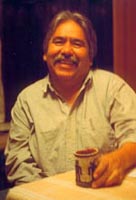
Feddersen employs diverse materials and methods in creating his body of work. While some editioned prints exist, most pieces are distinctly unique. He regularly combines such techniques as stenciled relief, chine colle, monotype, and silagraphy.
He is a long-standing faculty member at The Evergreen State College in Olympia, WA. where he teaches printmaking and other contemporary art issues. He is a member of the Confederated Colville Tribes.
Joe Feddersen, of Colville heritage, was born in 1953 in Omak, Washington, on the edge of the Colville Reservation. He first took up printmaking at Wenatchee Community College under the direction of printmaker Robert Graves, and then later studied with influential artists Glen Alps and Michael Spafford at the University of Washington, where he received his B.F.A. in 1983. He went on to receive an M.F.A. at the University of Wisconsin, Madison in 1989, and since that time has taught art at Evergreen State College in Olympia. Feddersen was honored with the prestigious Eiteljorg Fellowship for Native American Fine Art in 2001 and exhibited his work at the Smithsonian’s National Museum of the American Indian in New York City in 2003.
In his twenty-year career, Feddersen has worked in painting, three-dimensional constructions, photography, and computer-generated imagery, but he is best known as a virtuoso printmaker. This exhibition features recent prints from the Plateau Geometric Series (a series of prints inspired by Plateau Indian basket designs), the Tamas Series (inspired by imagery Feddersen associates with his maternal grandmother), and other work whose geometric designs are derived from Plateau artistry, itself inspired by Northwest landscapes, flora, and fauna.
Feddersen is first to note that his work does not copy from Plateau designs, but begins with them as a point of departure.
Feddersen is profoundly interested in exploring the complexities of a wide range of printmaking processes. Each of the Plateau Geometrics, for example, is a unique print, made with multiple media used sequentially, including aquatint, stencil relief, silagraphy (a silicon-based process), drypoint, and blind emboss. He is noted for his use of the blended roll, in which many colored inks are lain down at once in a single pass of the roller over the print matrix.
In the last few years, Feddersen learned to weave Plateau-style baskets, with the help of his Warm Springs friend, poet Elizabeth Woody. As he has mastered yet another medium, Feddersen has also kept true to one of his primary interests as an artist: to investigate the relationship between abstraction and figurative representation, a very modernist concern. This concern is easily seen in his prints, yet is also playfully explored in his baskets. The Urban Indian Suite of baskets, for example, takes a Plateau Indian form and infuses it with designs that abstractly evoke the symbols of contemporary urban life (chain link fences, bricks, parking lot lines, and so on).
Feddersen is truly one of the finest printmakers in the Northwest and one of the most accomplished artists of Native American heritage in the United States.
Artists Statement
My work investigates sign and cultural identity. This inquiry merges basic elements of basket designs from my ancestral home, the Inland Plateau region of the Columbia Basin, with urban imagery to speak to perceptions of land. My pieces address changes and attitudes of culture in changing times.
The glass basket shapes reposition traditional designs with those of urban sources to heighten the relationships to land and culture. Parking lot and cinder block patterns replace traditional designs like the mountain, butterfly or star designs. Each placed on a blown glass traditional basket form. The newest suite of urban vestiges gain strength by pulling source patterns from the corporate world of Bridgestone and Goodyear tire Companies – each pattern carrying the name of a tire line. What was once the traditional source of a pattern like the markings of a snake track in the sand is replaced with a new mark made by SUV tire track. These new names touch on names that speak of a romanticized, idealized West. Some names included are: Timberline, Wilderness, Eagle and Firehawk.
My woven baskets span my investigation of the form and content of the Cylinder or “Sally” bags from the Plateau region of Washington State. Each basket showcases a different approach to form and content. The Bearded Basket explores process—answering questions like what happens in one does this or that.
My print work builds from a dialogue with traditional basket designs. The prints typically build complexity through layering signs. Carrying segments of patterns, the plates become the linear structures of the compositions. Each layer printed on top of another entwines in a labyrinth of a modernist aesthetic. These signs tenuously dissolve into an overall field while still maintaining direct ties to my native heritage.
